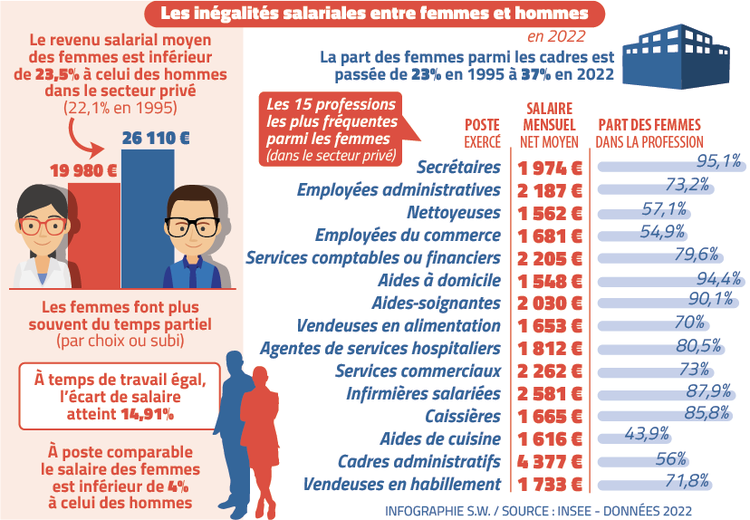Salaries: between women and men, persistent inequalities, the revelations of a study, what the figures say

Même si la situation s'améliore, les femmes restent pénalisées par rapport aux hommes. Midi Libre
The situation is improving, but women still earn 14.9% less than men, reveals INSEE.
Among the inequalities that cross our society, this remains one of the most glaring and impactful.
The average salary income of women is 23.5% lower in France than that of men in the private sector, reveals INSEE (National Institute of Statistics and Economic Studies), in its study of 2022 data, unveiled Tuesday, three days before International Women's Day. That is 26110 € annual for men compared to 19,980 € for women.
This gap is explained, in part, by a lower volume of annual work for women. Young women enter the job market later, because they are often more educated than men.
"A gendered distribution of professions"
Subsequently, when they start a family, almost a third of mothers do not have a full-time job because of the children, shows another survey, from the Drees (Directorate of Research, Studies, Evaluation and Statistics), published the same day.
The gaps are therefore even more marked between parents: mothers have significantly lower working hours and full-time equivalent salaries than fathers. And these gaps gradually grow with the number of births which have a greater impact on women's careers, observes INSEE.
"Professional segregation"
But, even for identical working hours, the average remuneration of women remains 14.9% lower than that of men. Since 1995, these inequalities have been slowly reducing (-7.2%). Certain injustices are erased and differences in work volume are reduced.
But "the differences in salary are mainly explained by the gender distribution of professions", analyzes the& rsquo;Insee which points to "professional segregation".
Professions: the higher salaries rise, the fewer women there are…
Translation: women often do not occupy the same type of job and, even if there are more female managers, still have less access to the positions that pay the most.
Illustration: while they occupy 41.8% of jobs in the private sector, their proportion rises to 54.6% for salary levels around 1,340 € monthly net income, then decreases as salaries rise. Women no longer represent more than a third of the workforce receiving a salary of at least €4,160.
The gap widens with age
And less than a quarter (22.8%) of the 1% best paid employees (above 9,970 euros). On the other hand,"for a comparable position, that is to say for the same profession carried out for the same employer, the full-time equivalent salary gap is reduced to 4%", estimates the institute.

"This salary gap for equivalent positions cannot be interpreted as a measure of salary discrimination in companies, because it is not not corrected for differences in characteristics not observed here such as experience, length of service in the company or diploma, differences which can affect it upwards or downwards", nuance l’Insee.
Big companies don't lead by example
This gap then widens with age. It is 4.7% for those under 25 and rises to 26.1% for those 60 or over. Wage inequalities between women and men also increase with the size of the company that employs them.
The gap is 7.9% on average in companies with fewer than 10 employees, but 18.2% in those with 5,000 or more employees . Multinationals are therefore far from setting an example.




